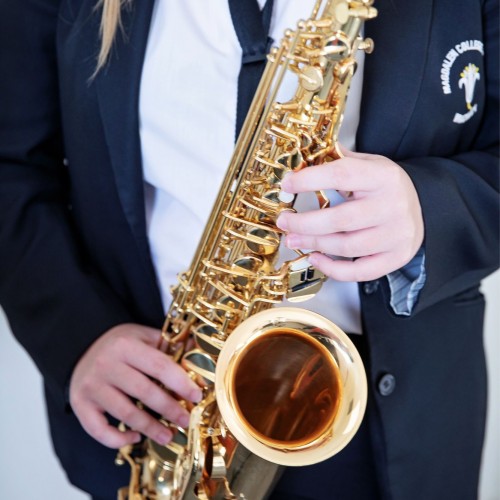Art, Design & Technology
The Art, Design and Technology Faculty is a dynamic and successful place to learn. Students are inspired to observe and question the world around them and encouraged to express themselves in a creative and independent way.
Across the faculty students might be solving a design problem, machining textile patterns, cooking a delicious meal, learning a programming language, or creating a work of art! All aspects of the curriculum will support individual growth through challenge.
Years 7 and 8
Students follow all of the subject disciplines to begin their learning at Magdalen. They gain skills and knowledge across key areas of each discipline as shown below. The specific order of experiences may vary given the rotation through different specialist areas and the availability of resources.
Art - Blended curriculum of Fine Art and Creative Textiles. Students gain competence with a variety of media, techniques, artists and genres.
Computing - Diverse curriculum of Computer Science, IT and Digital Literacy. Everyone learns about the safe use of digital tools & media.
Design Tech – Students gain core knowledge across plastics, metals, timbers, electronics, CAD/CAM, papers and boards. The lessons ask students to solve real problems.
Food – Every student will explore food hygiene, safety, healthy eating, where their food comes from and food science principles through practical and theory lessons.
Art
Computing
*’DL’: Digital Literacy & E-Safety. Topics covered in small chunks through the year
Food
Design Technology
Year 9, 10 & 11
Subject disciplines are offered to all students within the GCSE Options process. Each discipline in the ADT faculty provides increased challenge with time to develop personal responses alongside knowledge and skills.
Art -Students study either Fine Art or Creative Textile. Fine Art covers an understanding of technique, blended with an understanding of art history while Creative Textiles uses the same concepts but with a focus on fabric, threads and surface decoration and pattern
Computer Science - Encourages students to develop their understanding and application of the core concept. Students also analyse problems in computational terms and devise creative solutions by designing, writing, testing and evaluating programs.
Design Tech - Students follow either a Graphics or Resistant Materials pathway. Both cover theoretical knowledge and practical applications; using papers and boards in Graphics, while Resistant Materials uses timbers and plastics.
Food – the subject discipline develops students’ knowledge, understanding and skills to apply the principles of food science, nutrition and healthy eating. Pupils learn about improving lives through better knowledge of food, where it comes from and how it affects our bodies. Students will undertake interesting science experiments to explore the function and chemical properties of ingredients, and to improve their own cooking practice.
IT - Students develop their knowledge and understanding of different hardware and software applications and the tools and techniques used to select, store, manipulate and present data. They also explore the various risks associated with the collection, storage and use of data, including legal, moral, ethical and security issues, and how such risks can be mitigated. This is a practical course where students apply theoretical knowledge to real world scenarios.
GCSE Art
GCSE Creative Textiles
GCSE Computer Science
GCSE Design & Technology
GCSE Food & Nutrition
GCSE ICT
Years 12 & 13
The ADT faculty offers four disciplines for further study in the Sixth Form. As in other subjects there is an increase in challenge, complexity and content.
Art & Creative Textiles - Both A Level pathways will allow students to explore their creativity through a range of styles and techniques. By the end of the course, students will have produced a portfolio of work and a 2,000-word thematic essay. Both courses are taught in small groups, and there is an emphasis on guided practical work. Visits to local and national art exhibitions are woven into the courses to expose students to a range of artists, designers and styles.
Computer Science - A practical subject where students can apply the academic principles learned in the classroom to real-world systems. Students will develop the ability to apply the fundamental principles and concepts of computer science, to analyse problems in computational terms and to think creatively and logically. In Y13 there is a significant focus on mathematical skills.
Design Tech - This creative and thought-provoking qualification gives students the practical skills, theoretical knowledge and confidence to succeed in a number of careers, such as the creative industry. Students will investigate historical, social, cultural, environmental and economic influences on design and technology, whilst enjoying opportunities to put their learning in to practice by producing prototypes of their choice. Students can personalise their major NEA project as a stepping-stone to the next stage in their career. Students will gain a real understanding of what it means to be a designer, alongside the knowledge and skills sought by higher education and employers.
A Level Art
A Level Creative Textiles
A Level Computer Science
A Level Design & Technology (Product Design)
CAREERS: HOW CAN YOU TAKE STUDYING ADT FURTHER?
Career links with Art and Design
Career links with Computer Science
Career links with Design Technology
Career links with Food and Nutrition

















